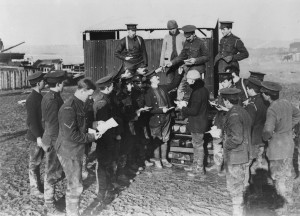
Should Canada and its allies intervene in Syria?
Face to face: Does the UN principle of responsibility to protect oblige Canada and its allies to intervene – militarily or otherwise – in Syria?

Face to face: Does the UN principle of responsibility to protect oblige Canada and its allies to intervene – militarily or otherwise – in Syria?

Winston Churchill and Adolph Hitler were both charismatic, demanding leaders who promised to restore order to their society after the disruption and devastation of the

Canadians on Salisbury Plain, receiving their Christmas Cards. 1914-1919

1 January 1885 Standard time goes into effect, the brainchild of Canadian Pacific Railway chief engineer Sir Sandford Fleming. 2 January 1940 The first Canadians
Stan Knight of Bobcaygeon, Ont., writes: During the Second World War, our escort group ran a convoy with HMS Revenge. The mighty Revenge sat steady
Legion Magazine presents a special Christmas tribute video to our soldiers and military history. Merry Christmas and Happy Holidays from all of us at Legion



Get the latest stories on military history, veterans issues and Canadian Armed Forces delivered to your inbox. PLUS receive ReaderPerks discounts!

| Cookie | Duration | Description |
|---|---|---|
| cookielawinfo-checkbox-analytics | 11 months | This cookie is set by GDPR Cookie Consent plugin. The cookie is used to store the user consent for the cookies in the category "Analytics". |
| cookielawinfo-checkbox-functional | 11 months | The cookie is set by GDPR cookie consent to record the user consent for the cookies in the category "Functional". |
| cookielawinfo-checkbox-necessary | 11 months | This cookie is set by GDPR Cookie Consent plugin. The cookies is used to store the user consent for the cookies in the category "Necessary". |
| cookielawinfo-checkbox-others | 11 months | This cookie is set by GDPR Cookie Consent plugin. The cookie is used to store the user consent for the cookies in the category "Other. |
| cookielawinfo-checkbox-performance | 11 months | This cookie is set by GDPR Cookie Consent plugin. The cookie is used to store the user consent for the cookies in the category "Performance". |
| viewed_cookie_policy | 11 months | The cookie is set by the GDPR Cookie Consent plugin and is used to store whether or not user has consented to the use of cookies. It does not store any personal data. |



Free e-book
An informative primer on Canada’s crucial role in the Normandy landing, June 6, 1944.